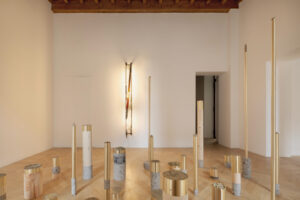
Mateusz Choróbski, Hide And Seek, installation view, Milan, 2023. Ph Stefano Maniero. Courtesy the Artist and Secci, Florence, Milan
The installation in the first room of the exhibition “Hide and Seek”, 37 Old Road #1/ #2/ #3 (2022), consists of three large sculptures composed of door jambs torn from the corridors of the artist’s family home, and then coated and immersed in children’s soap with an intense scent. Time — not “lost” and not thought of with nostalgia, but analyzed and worked on by the artist until he can give it shape, intertwining various psychological and social issues — is one of the tools used to compose this exhibition. The only sources of light in the room are the longitudinal works, created by used domestic stoves, cupping pots and the interior of some thermos in molten glass. The choice of materials has the same conceptual basis as the previous installation: it is a careful investigation of everyday life, the most raw and essential scenography of our lives. Choróbski causes the reversal or abandonment of functions in objects, some of which were once essential for maintaining life. The installations aim at transformation, becoming an emblem of rebirth.
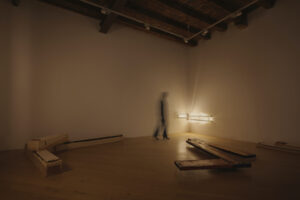
Mateusz Choróbski, Hide And Seek, installation view, Milan, 2023. Ph Stefano Maniero. Courtesy the Artist and Secci, Florence, Milan
In the second room prevails installation 2329,77/4 (2023). It is formed by 30 structures in the form of cylinders composed of melted coins of 0.01 PLN, concrete, brick, terrazzo, and wood. The number in the title refers to the current “poverty line” that exists in Poland, defined as the minimum income necessary for a person to meet their biological needs such as food, housing and clothing. 2329,77/4 continues the cycle of works in which the artist delves into the themes of economic exclusion, the poverty threshold, social stratification and how the regulations of the governing bodies are responsible for shaping the existence of its citizens. The titles of the works created by the artist dated to the previous years, 819,19/2, 997,10/2 and 1056,24/2, illustrate how the estimation of the poverty line changes every year. The arrangement of the cylindrical structures imitates that of the calendar, where each of the thirty structures corresponds to one day of the month. The base of each cylinder is made from cement waste and construction waste from residential buildings, while the top layer consists of different amounts of melted brass coins, with a nominal value of 0.01 PLN. The total sum of the value of all coins cast in the installation is PLN 2,329.77, which represents the amount of the minimum subsistence income for a family of four in Poland in the current year.
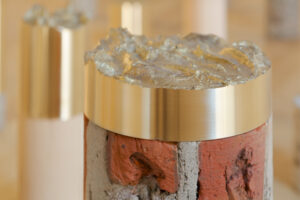
Mateusz Choróbski, 2329,77/4 (detail), Ph Stefano Maniero. Courtesy the Artist and Secci, Florence, Milan
As the curator explains, the installation “reflects the disillusioned conviction of the social hierarchy, a division into those who occupy the “upper” and “lower” strata of society”. The solid and cold forms, which refer to the idea of a bar graph, are juxtaposed with the fragility of human life, with its organic side in the most extreme form – a potential for survival. 405973 km(2022), previously displayed at the exhibition “Warszawa w Budowie” at the Warsaw Museum of Modern Art, is another installation consisting of coins. The shapes mirror the tank of Choróbski’s car, a 1999 WV Passat, cut into pieces. The artist, after selling his car to a junkyard, exchanged the amount received with coins that he later melted to form the pieces of the tank. A car belonging to the lower class, almost an object of ridicule, is however the object that helped build the capital of the Polish families in the 2000s, and is here transformed into a purely aesthetic form, which refers to the idea of mosaic, which was originally composed through pieces of waste.
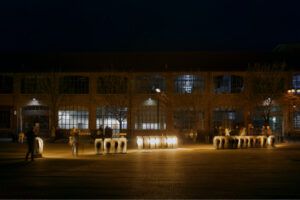
Mateusz Choróbski, Hide And Seek, installation view at Fabbrica del Vapore, Ph Stefano Maniero. Courtesy the Artist and Secci, Florence, Milan
A large installation specially designed for the monumental spaces of the Fabbrica del Vapore is the second stage of the project “Hide and Seek”. The artist tries to define the forms and visual perception of space through the manipulation of light within a public space. The work on display at the Fabbrica del Vapore resembles a lighthouse that shines by rotating counterclockwise once an hour, recalling the passage of time.
Dobrosława Nowak
Info:
Mateusz Choróbski, Hide and Seek
curated by Pier Paolo Pancotto
09/03 – 27/05/2023
Secci, Milan
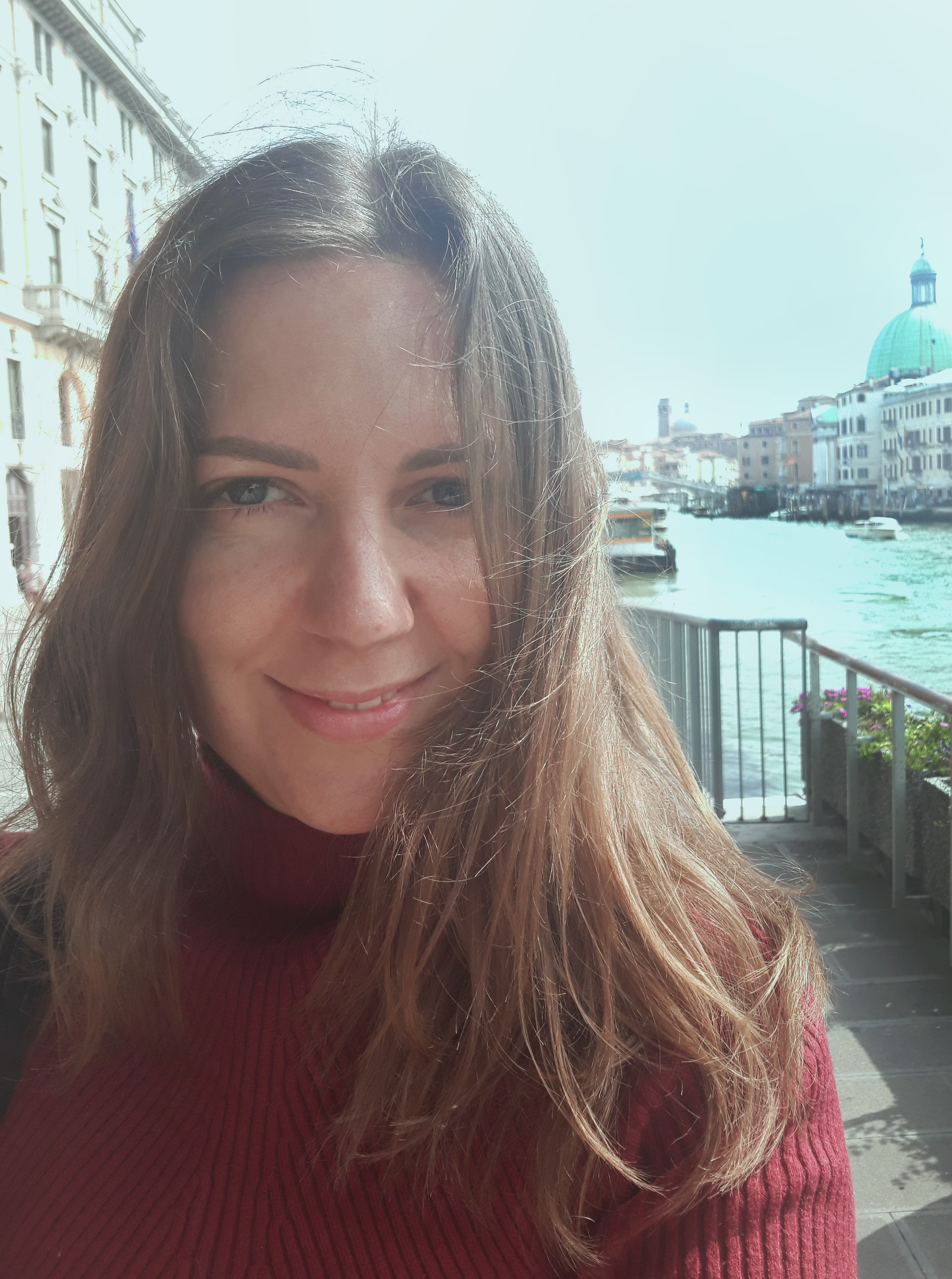
Graduated in Photography and Visual Recording Arts at the University of Art in Poznan (Poland) in 2013. Graduated in Psychology from Adam Mickiewicz University in Poznan in 2015. In 2018 she attended the “Latest Trends in Visual Arts” course at Brera Academy of Fine Arts. She writes art texts for various magazines in English, Italian, French and Polish. Artist, curator and researcher. Born in Poland, she lives and works in Milan.






NO COMMENT